Article contents
Unlocking the Groove: Rhythm, Meter, and Musical Design in Electronic Dance Music. By Mark Butler. Bloomington: Indiana University Press, 2006.
Published online by Cambridge University Press: 01 May 2008
Abstract

- Type
- Book Review
- Information
- Journal of the Society for American Music , Volume 2 , Issue 2: Special issue on Technology and Black Music in the Americas , May 2008 , pp. 269 - 276
- Copyright
- Copyright © The Society for American Music 2008
References
1 Rietveld, Hillegonda C., This Is Our House: House Music, Cultural Spaces, and Technologies (Brookfield, Vt.: Ashgate, 1998)Google Scholar; Malbon, Ben, Clubbing: Dancing, Ecstasy, and Vitality (New York: Routledge, 1999)Google Scholar; and Fikentscher, Kai, “You Better Work!” Underground Dance Music in New York City (Hanover, N.H.: Wesleyan University Press, 2000)Google Scholar.
2 Korsyn, Kevin, Decentering Music: A Critique of Contemporary Musical Research (Oxford: Oxford University Press, 2003), 21–23.CrossRefGoogle Scholar
3 Fikentscher, , “You Better Work!” 58Google Scholar, quoted in Butler, Unlocking the Groove, 73. See also Small, Christopher, Music of the Common Tongue: Survival and Celebration in African-American Music (Hanover, N.H.: Wesleyan University Press, 1998)Google Scholar.
4 Radano, Ronald and Bohlman, Philip, eds., Music and the Racial Imagination (Chicago: University of Chicago Press, 2000), 1.Google Scholar
5 Rietveld, This Is Our House, 26, quoted in Butler, 8, and further cited in Butler, 8 n. 5.
6 Iyer, Vijay, “Microstructures of Feel, Macrostructures of Sound: Embodied Cognition in West African and African-American Musics” (Ph.D. diss., University of California, Berkeley, 1998)Google Scholar.
7 Temperley, David, “Syncopation in Rock: A Perceptual Perspective,” Popular Music 18/1 (January 1999): 19–40CrossRefGoogle Scholar; Lerdahl, Fred and Jackendoff, Ray, A Generative Theory of Tonal Music (Cambridge, Mass.: MIT Press, 1983)Google Scholar.
8 Washburne, Christopher, “The Clave of Jazz: A Caribbean Contribution to the Rhythmic Foundation of an African-American Music,” Black Music Research Journal 17/1 (Spring 1997): 59–80.CrossRefGoogle Scholar
9 For further discussion, see Iyer, “Microstructures of Feel, Macrostructures of Sound.”
10 Bourdieu, Pierre, Outline of a Theory of Practice, trans. Nice, Richard (Cambridge: Cambridge University Press, 1977)CrossRefGoogle Scholar; and Berger, Harris M., “The Practice of Perception: Multi-Functionality and Time in the Musical Experiences of a Heavy Metal Drummer,” Ethnomusicology 41/3 (Autumn 1997): 464–88.CrossRefGoogle Scholar
11 Hasty, Christopher, Meter as Rhythm (Oxford: Oxford University Press, 1997)Google Scholar.
- 2
- Cited by




